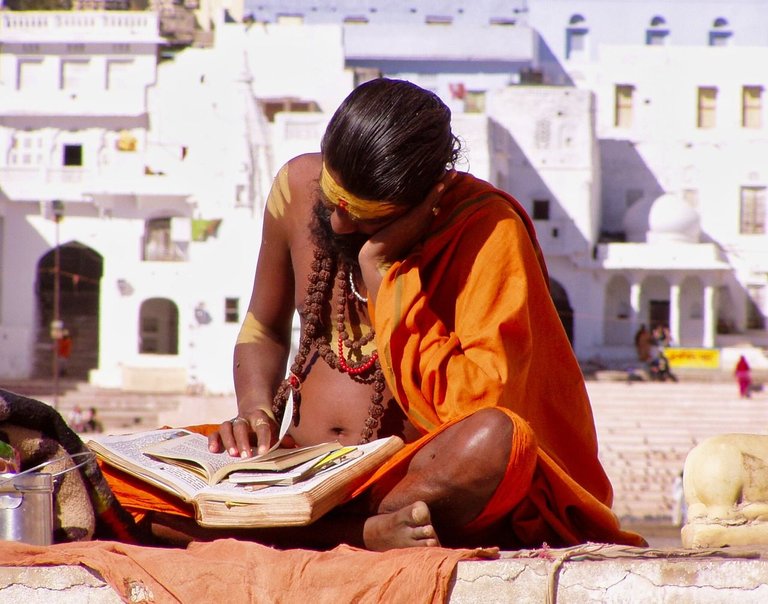With a million dollars, all your ten dollar problems are solved. Or as the Vedas say, a great reservoir of water can serve the needs of many small ponds. Not that I can claim to know the Vedas. They are a vast Sanskrit body of knowledge said to be the oldest on the planet and the most voluminous regarding civilized life and consciousness. Knowing the Vedas in full might take a lifetime to assimilate. Better to know the Vedanta or conclusion of the Vedas by hearing it summed up by someone who already knows the purpose of the Vedas personally. Like a scholar. Or better still, a practitioner of the Vedas.

To learn all the intricate prayers and rituals of the Vedas would not be possible for me in this lifetime. I have begun my inquiry too late. In fact, few people at all today are qualified to tackle the full study and application of the Vedas. Some brahmana priests in India running a temple may come close to it. But overall, those of us born in this age of Kali – the last of the four great ages – do not live long enough or have the mental capacity to master Vedanta or the lifestyle of a brahmana who is meant to know mantras and rituals to perform offerings to the deity, known as arotika, or puja, or agni hotra (fire sacrifice).
However, fortunately that is not necessary in this day an age in order to master the goal of life, namely liberation from the wheel of samsara, or repeated birth and death. Brahminical life is very strict and involves cleanliness and punctuality, along with a very regulated daily lifestyle filled with study, and meditation.

For example, in my youth between the ages of 19 to 29, I lived and trained in strict brahminical studies and training in the yoga ashram and temple of my guru or spiritual teacher. For those ten years, I awoke daily at 04h00 to catch the most auspicious hour of the day for meditation – the brahma muhurta, which is 90 minutes before sunrise onward. Then I and the other students would sit for two hours of meditation, softly reciting our mantra repeatedly. Thereafter we would perform some more ceremonies and then have class for an hour on the Vedic texts. This was almost every day of the week throughout the year, whichever temple I traveled to during those ten years. Some temples were in my home country of South Africa and some were in India, where I did extra studies for some months at a time.
This was a brahminical life and as a monk for those ten years, I never touched alcohol, intoxicants, meat, or women. I never read newspapers or novels and it was the 1990s before the era of internet or cellular phones. So I know what is required to live a civilized brahminical life. I mention this simply to give some context and so that you know I am not simply theorizing but that I have experience in Vedic life. And yet I am not a perfect example today of a pukka brahmana. In fact I’m worse than a sudra, and am born an outcaste, not even in the Aryan civilization of India.
India, after all, is the original root of the Aryan culture and home of Aryan civilization, despite what some scholars may speculate about their roots further north west. In the Gita, Krishna calls Arjuna an Aryan to his face, reminding him of his family. The name Aryan may have been borrowed by the Third Reich during World War 2 in the middle of last century, but original Aryan means Vedic or Bharat or India, as we call it today.
Vedic culture is Aryan, which is brahminical, or based on knowledge of spirit or brahman. Now that goal of knowledge of matter and spirit no longer requires the study of the entire Veda. That has already been done by past seekers and aspirants. And they have summed up the entire goal of the Vedas as been to return back to godhead, back to the source, Krishna. And the technique requires the knowledge of only one mantra out of all the Vedas, and that mantra is the one containing the names of your deity or divinity. In my case, as a student of Bhagavad Gita, I apply the names of the speaker of the Gita, Krishna, in my mantra meditation. That is the method for this age, mantra meditation.
By using just this one mantra, one can fulfil the purpose of the entire Veda. All the other rituals to the multiple demigods, forefathers, ancestors, saints and sages are all fulfilled by the simple process of Harinama japa, mantra meditation, on a daily basis. Using sound vibration, the pineal is activated and the heart is also opened. This is a technique available to anyone, even those outside of the Aryan culture, or the brahminical standard of life. It is transcendental. And that is the potency of such a process. With this million dollar mantra, all your Vedic mantras, duties and rituals are already fulfilled.
When it comes to knowing Vedanta, I am a fool and an outcaste, but still, I have the one mantra out of all of them, that is the only one I need to perfect my life and attain the goal in this lifetime. Or if not, then at least take my next birth in a brahminical family, perhaps back in India, where I can continue my pursuit of liberation with even more facility. Hare Krishna.

Bhagavad Gita ch2:46
यावानर्थ उदपाने सर्वतः सम्प्लुतोदके ।
तावान्सर्वेषु वेदेषु ब्राह्मणस्य विजानतः ॥ ४६ ॥
yāvān artha udapāne
sarvataḥ samplutodake
tāvān sarveṣu vedeṣu
brāhmaṇasya vijānataḥ
yāvān—all that; arthaḥ—is meant; udapāne—in a well of water; sarvataḥ—in all respects; sampluta-udake—in a great reservoir of water; tāvān—similarly; sarveṣu—in all; vedeṣu—Vedic literatures; brāhmaṇasya—of the man who knows the Supreme Brahman; vijānataḥ—of one who is in complete knowledge
TRANSLATION
All purposes that are served by the small pond can at once be served by the great reservoirs of water. Similarly, all the purposes of the Vedas can be served to one who knows the purpose behind them.
COMMENTARY
The rituals and sacrifices mentioned in the karma-kāṇḍa division of the Vedic literature are to encourage gradual development of self-realization. And the purpose of self-realization is clearly stated in the Fifteenth Chapter of the Bhagavad-gītā (15.15): the purpose of studying the Vedas is to know Lord Kṛṣṇa, the primeval cause of everything. So, self-realization means understanding Kṛṣṇa and one's eternal relationship with Him. The relationship of the living entities with Kṛṣṇa is also mentioned in the Fifteenth Chapter of Bhagavad-gītā. The living entities are parts and parcels of Kṛṣṇa; therefore, revival of Kṛṣṇa consciousness by the individual living entity is the highest perfectional stage of Vedic knowledge. This is confirmed in the Śrīmad-Bhāgavatam (3.33.7) as follows:
aho bata śvapaco'to garīyān
yaj-jihvāgre vartate nāma tubhyam
tepus tapas te juhuvuḥ sasnur āryā
brahmānūcur nāma gṛṇanti ye te.
"O my Lord, a person who is chanting Your holy name, although born of a low family like that of a cāṇḍāla [dog eater], is situated on the highest platform of self-realization. Such a person must have performed all kinds of penances and sacrifices according to Vedic rituals and studied the Vedic literatures many, many times after taking his bath in all the holy places of pilgrimage. Such a person is considered to be the best of the Āryan family." So one must be intelligent enough to understand the purpose of the Vedas, without being attached to the rituals only, and must not desire to be elevated to the heavenly kingdoms for a better quality of sense gratification. It is not possible for the common man in this age to follow all the rules and regulations of the Vedic rituals and the injunctions of the Vedāntas and the Upaniṣads. It requires much time, energy, knowledge and resources to execute the purposes of the Vedas. This is hardly possible in this age. The best purpose of Vedic culture is served, however, by chanting the holy name of the Lord, as recommended by Lord Caitanya, the deliverer of all fallen souls. When Lord Caitanya was asked by a great Vedic scholar, Prakāśānanda Sarasvatī, why He, the Lord, was chanting the holy name of the Lord like a sentimentalist instead of studying Vedānta philosophy, the Lord replied that His spiritual master found Him to be a great fool, and thus he asked Him to chant the holy name of Lord Kṛṣṇa. He did so, and became ecstatic like a madman. In this age of Kali, most of the population is foolish and not adequately educated to understand Vedānta philosophy; the best purpose of Vedānta philosophy is served by inoffensively chanting the holy name of the Lord. Vedānta is the last word in Vedic wisdom, and the author and knower of the Vedānta philosophy is Lord Kṛṣṇa; and the highest Vedantist is the great soul who takes pleasure in chanting the holy name of the Lord. That is the ultimate purpose of all Vedic mysticism.
Reference: Bhagavad Gita As It Is, translation and commentary by Swami A. C. Bhaktivedanta, original 1972 Macmillan edition (www.prabhupadabooks.com)
Images: www.pixabay.com




